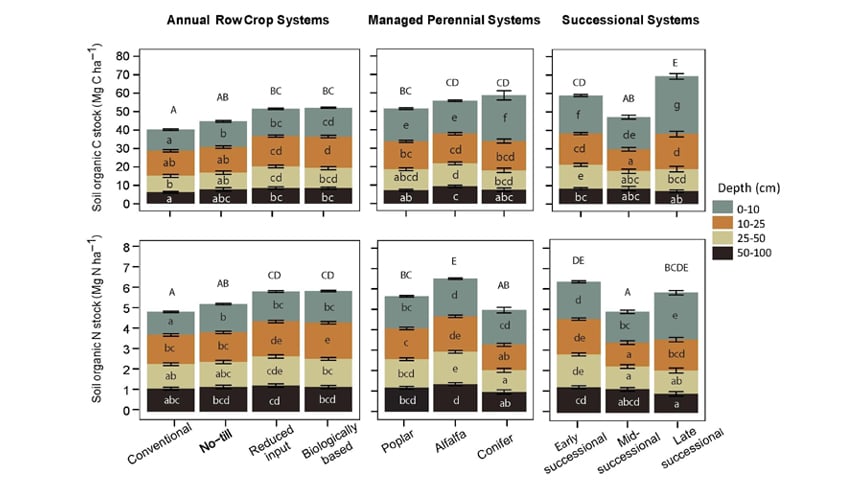Changes in soil organic carbon (SOC) and nitrogen (SON) are strongly affected by land management but few long-term comparative studies have surveyed changes throughout the whole soil profile.
However, researchers at Michigan State University have recently reported on a long-term examination of soil carbon change in 10 replicated ecosystems over 25 years. They found that whole profile soil carbon gain was greater in diverse perennial systems and found no evidence of subsurface carbon loss in no-till or other systems.
They quantified 25-year SOC and SON changes to 1m in 10 replicate ecosystems at an Upper Midwest, USA site.
They compared four annual cropping systems in maize (zea mays)-soybean (glycine max)-winter wheat (triticum aestivum) rotations, each managed differently (conventional, no-till, reduced input, and biologically based); in three managed perennial systems (hybrid poplar (populus × euramericana), alfalfa (medicago sativa), and conifer (pinus spp.); and in three successional systems (early, mid- and late succession undergoing a gradual change in species composition and structure over time).
Reduced input and biologically based systems included winter cover crops.
Neither SOC nor SON changed significantly in the conventional or late successional systems over 25 years.
All other systems gained SOC and SON to different degrees.
Whole-profile soil carbon accretion over 25 years of differential land management differed substantially along a management intensity gradient that spanned annual row crops, perennial biomass crops, and successional systems.
In almost all cases, rates of accretion slowed from the first 12 years of alternative management.
Overall, the researchers concluded that effective strategies to accumulate SOC and SON in managed ecosystems should consider the inclusion of diverse species (e.g., the inclusion of winter cover crops in annual cropping systems), perennial crops (whether herbaceous crops like alfalfa or woody crops like hybrid poplar), and no-till annual crops.
Diverse perennial plantings such as those represented by early successional vegetation (burned or possibly harvested annually for biofuel) demonstrated the fastest rates of SOC accumulation.
